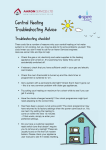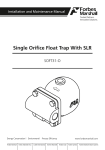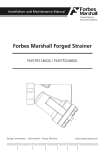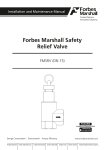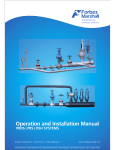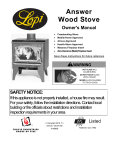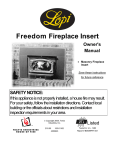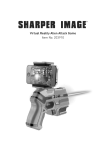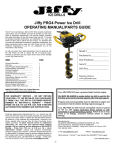Download Compact Pressure Powered Pump Package Unit
Transcript
Installation and Maintenance Manual Compact Pressure Powered Pump Package Unit with IJ and CRM485R PPPPU-C Forbes Marshall Forbes Marshall Arca Codel International Krohne Marshall Forbes Solar Forbes Vyncke Forbes Marshall Steam Systems Table of Contents 1. Preface ................................................................................1 2. Important Safety Notes ........................................................1 3. Brief Product Information .....................................................3 4. Product Working Principle ...................................................7 5. Installation Guidelines .........................................................8 6. Startup and Commissioning ................................................10 7. Maintenance Guidelines .....................................................11 8. Troubleshooting .................................................................15 9. Available Spares ................................................................17 10. Warranty Period .................................................................17 PLEASE NOTE - Throughout this manual this cautionary symbol is used to describe a potential damage or injury that might occur if the safety considerations are overlooked. This symbol denotes CAUTION, WARNING or DANGER. Compact Pressure Powered Pump Package Unit with IJ and CRM485R 1. Preface: This manual is intended for anyone using, commissioning, servicing, or disposing the below mentioned products safely and efficiently. 1. Compact Pressure Powered Pump Package Unit with IJ and CRM485R [PPPPU-C] Size: DN20 (3/4'') , DN25 (1'') PLEASE NOTE Throughout this manual the following cautionary symbol is used to describe a potential damage or injury that might occur if the safety considerations are overlooked. 2. Important Safety Notes: Read this section carefully before installing/operating/maintaining the product. The precautions listed in this manual are provided for personnel and equipment safety. Furthermore, Forbes Marshall accepts no responsibility for accidents or damage occurring as a result of failure to observe these precautions. Note that the product is designed to perform for non-contaminated fluids only. A contamination in the form of chemical, foreign particle etc. can lead to problem with product performance and life of the product. If these products in compliance with the operating instructions are, properly installed, commissioned, maintained and installed by qualified personnel (refer Section 2.7) the safety operations of these products can be guaranteed. General instructions for proper use of tools and safety of equipments, pipeline and plant construction must also be complied with. 2.1 Intended use: Check if the product is suitable for intended use/ application by referring to the installation and maintenance instructions, name plates and technical information sheets. i) The product is suitable for use as defined in the technical information sheet. In case the need arises to use the product on any other fluid please contact Forbes Marshall for assistance. ii) Check for the suitability in conformance to the limiting conditions specified in technical information sheet of the product. iii) The correct installation and direction of fluid flow has to be determined. iv) Forbes Marshall products are not intended to resist external stresses, hence necessary precautions to be taken to minimize the same. 2.2 Accessibility and Lighting: Safe accessibility and working conditions are to be ensured prior to working on the product. 2.3 Hazardous environment and media: The product has to be protected from hazardous environment and check to ensure that no hazardous liquids or gases pass through the product. PPPPU-C 1 2.4 Depressurizing of systems and normalizing of temperature: Ensure isolation and safety venting of any pressure to the atmospheric pressure. Even if the pressure gauge indicates zero, do not make an assumption that the system has been depressurized. To avoid danger of burns allow temperature to normalize after isolation. 2.5 Tools and consumables: Ensure you have appropriate tools and / or consumables available before starting the work. Use of original Forbes Marshall replacement parts is recommended. 2.6 Protective clothing: Consider for the requirement of any protective clothing for you/ or others in the vicinity for protection against hazards of temperature (high or low), chemicals, radiation, dangers to eyes and face, noise and falling objects 2.7 Permits to work: All work to be carried out under supervision of a competent person. Training should be imparted to operating personnel on correct usage of product as per Installation and Maintenance instruction. “Permit to work” to be complied with (wherever applicable), in case of absence of this system a responsible person should have complete information and knowledge on what work is going on and where required, arrange to have an assistant with his primary goal and responsibility being safety. “Warning Notices” should be posted wherever necessary. 2.8 Handling: There is a risk of injury if heavy products are handled manually. Analyze the risk and use appropriate handling method by taking into consideration the task, individual, the working environment and the load. 2.9 Freezing: Provision should be made to protect systems which are not self-draining, against frost damage (in environment where they may be exposed to temperatures below freezing point) to be made. 2.10 Returning products: Customers and Stockist are reminded that, when returning products to Forbes Marshall they must provide information on any hazards and the precautions to be taken due to contamination residues or mechanical damage which may present a health, safety or environmental risk. This information must be provided in writing including Health and Safety data sheets relating to any substances identified as hazardous or potentially hazardous. 2 Compact Pressure Powered Pump Package Unit with IJ and CRM485R 3. Brief Product Information: 3.1 Description: The Forbes Marshall Compact Pressure Powered Pump Package Unit, PPPPU-C, is a positive displacement pump unit operated by steam, compressed air or pressurised gas. The compact pump has an in-built receiver for condensate, which eliminates the need for a separate storage tank. The size enables this pump to be used with individual equipment also. The pump is specifically designed to pump hot condensate. DN 20 PPPPU-C DN 25 PPPPU-C All Dimensions in ‘mm’ Figure 1 : Compact Pressure Powered Pump Package Unit Sr.no. 1 2 3 4 5 6 7 8 9 10 11 12 13 14 15 16 17 PPPPU-C Description PPPPU-C Shell Exhaust Elbow Overflow Socket Reciever Shell Condensate Inlet Line Ball Valve For Condensate Inlet DN20 Strainer DN25 Check valve for condensate inlet DN25 Check valve for condensate outlet DN15 Drain DN15 Piston Valve For Steam Inlet Connection DN15 Strainer Steam Inlet Cover Plate Assembly DN15 MLT21 Trap Leg Support Condensate Inlet Conn. DN20 Flanged to BS 10 TAB 'E' Vent Connection DN50 Flanged to ANSI # 150 Material MS ERW Pipe MS MS MS ERW Pipe MS Carbon Steel C.I. S.S. S.S. MS FCS CI CI SS MS CS CS 3 Figure 2 : Mechanism detail of PPPPU-C 4 Sr.no. Description 1 Cover Material Cast iron 2 3 4 5 6 7 8 9(a) 9(b) 10 11 12 13 14 15 16 17 Synthetic Fibre Cast steel S.S. Type 304 S.S. Type 304 Stainless steel Copper S.S. Type 304 S.S. Type 304 S.S. Type 304 Copper S.S. Type 304 S.S. Type 304 Cast iron Stainless steel Cast steel S.S. Type 304 Stainless steel 18 Cover Gasket Stud and Nut M·12 Inlet Valve Seat Inlet Valve Stem Inlet Valve Head Inlet Seat Gasket Exhaust Valve Exhaust Valve Exhaust Valve Head Exhaust Seat Gasket Valve Actuator Disc Push Rod Mechanism Mechanism Studs M12 Body Float Linage Mechanism Push Rod Actuator Stainless steel 19 20 21 22 23 Spring Plug 1/2”BSPT Check Valve Flow-temp Sensor Sensor Float Inconel Forged Carbon Steel Stainless steel Stainless steel S.S. Type 304 Standard IS 210 Gr FG 260 ASTM A276 ASTM A276 ASTM A276 ASTM A276 ASTM A276 ASTM A276 ASTM A240 IS 210 FG 260 IS 1364 IS 2062 ASTM A240 ASTM A351 CF 8 ASTM A351 CF 8 ASTM A105 ASTM A240 Compact Pressure Powered Pump Package Unit with IJ and CRM485R 3.2 Size and Pipe Connections Pump Size (DN) Inlet connection (DN) ANSI # 150 Outlet connection (DN) Flange BS 10 20 20 20 Tab ‘H’ 25 25 40 Tab ‘E’ 3.3 Limiting Conditions Design conditions PMA Maximum design pressure TMA Maximum design temperature Operating inlet motive pressure 8.7 bar g 220°C Steam / Compressed Air / Pressurised gas 3 to 7 bar g (Max) Pump discharge per cycle 30 Kg Steam consumption 3 Kg of steam per 1000 Kg condensate pumped Air consumption 22 SCF per 1000 Kg condensate pumped Minimum operating temperature 0°C Note: For lower operating temperatures consult Forbes Marshall 3.4 Operating Range 3.5 Standard Accessories • Condensate recovery meter - 485 (CRM485R) • Insulation jacket 3.6 How to Select and Size: From the inlet pressure (motive pressure) and back pressure conditions given below, select the pump size which meets the capacity requirement of the application. Select optional extras, as required. Back pressure is the lift height (H) in mtr x 0.1 plus bar (g) in return line plus downstream piping friction pressure drop in bar (g) at the lesser of six times the actual flow rate or 340 lit/min. PPPPU-C 5 3.7 Capacity kg/hr: For liquid specific gravity (0.9 to 1) No. 1 2 3 4 5 6 7 8 9 10 11 12 13 14 15 16 17 18 INLET Pr. TOTAL Lift (M.P.) (bar g) Or Back Pr. (bar g) 8.7 8.7 8.7 8.7 7 7 7 7 6 6 6 6 5 5 5 4 4 3 1 2 3 4 1 2 3 4 1 2 3 4 1 2 3 1 2 1 Condensate Flow Rate (Kg/hr.) DN20 Compact Pump kg/hr 600 514 482 470 590 550 475 390 580 520 425 300 550 430 320 440 340 325 3.8 Example: Condensate load Steam / air pressure available for Operating pump Vertical lift from pump to the return piping Pressure in return piping (piping friction negligible) DN25 Compact Pump kg/hr 1020 900 800 780 900 900 800 780 900 900 800 690 900 840 720 840 720 660 = 450 kg/hr = 7 bar g =9m = 1.72 bar g Solution: 1. Calculate “H”, the total lift or back pressure against which the condensate must be pumped = (9m x 0.1) + 1.72 = 2.62 2. From capacity table : 7 bar g operating inlet pressure and 3 bar g back pressure pump has a capacity of 475 kg/hr. Note from capacity factor charts: Pump capacity using compressed air (% BP / MP = 3/7) = 42% = 1.1 X 475 = 522 kg/hr 3.9 Capacity multiplying factors for motive gas supplies (other than steam) 6 Compact Pressure Powered Pump Package Unit with IJ and CRM485R 4. Product Working Principle : Note: For this section refer to Figure 1 A PPPPU-C unit consists of a receiver (4), Inlet Isolation valve (6), Strainer (7), a body shell (1) containing a float mechanism which operates a set of motive steam / air inlet and exhaust line (2) and inlet (8) & outlet (9) disc check valves. The steam or air is used as motive media to operate the pump. Condensate comes into the pump receiver (4) from Flash vessel or plant condensate header and is allowed to flow in to the pump body (1) having float mechanism by opening the inlet isolation valve (6). Note: For this section refer to Figure 2 In the normal position before startup the float is at the lowest position with the motive steam/air valve (5) closed and the exhaust valve open (9A). When condensate flows by gravity through inlet check valve in to pump body (15), the float (16) will rise along with the level of condensate. As the float (16) continues to rise, the mechanism link (17) is engaged which increases tension in the springs (19). When the float (16) has risen to its upper tripping position, the linkage mechanism (17) snaps upward over center. The energy in the springs (19) is released as the push rod (18) is moved upward, to simultaneously open the motive steam inlet valve (5) and close the exhaust valve (9A). Steam flow through the inlet valve (5) increases the pressure within the body and closes the inlet check valve. The increased pressure in the body shell (15) exceeds the backpressure in the condensate discharge line, it opens the discharge check valve (21) to pump out the condensate in the discharge line. As the condensate level in the pump body (15) falls, the float (16) is lowered and mechanism link (17) is engaged, which again increases the tension in the springs (19). When the float (16) reaches the lower tripping position, the linkage mechanism (17) snaps downward over center. The energy in the springs (19) is released as the push rod (18) is moved downward, to simultaneously open the exhaust valve (9A) and close the steam inlet valve (5). Steam / air utilized for pumping the condensate gets released to through exhaust valve and this completes one pumping stroke. When the pressure in the pump body (15) has fallen below the pressure in the inlet pipe, the inlet check valve opens. Condensate will again flow through the check valve to fill the body and begin next cycle. PPPPU-C 7 5. Installation Guidelines : Note: Before implementing any installations observe the 'Important Safety notes” in section 2. Referring to the Installation and Maintenance Instructions, name-plate and Technical Information Sheet, check that the product is suitable for the intended installation. Note: For this section refer to Figure 3 1. 2. 3. 4. 5. 6. 7. Ensure that there is no damage in transit. Before installation is done ensure that all steam, air or gas lines are closed. Select correct pipeline sizes as per the pump and connections are available. Level the unit by level bottle. The reservoir has 3 ports, two of them should be connected for condensate inlet (A) and third is used for vent line ©. Most important is that reservoir must be vented to atmosphere. This is to ensure free flow of condensate under gravity to the pump. It is recommended to install PPPPU along with a Forbes Marshall Flash vessel arrangement, if condensate flashing is expected when exposed to atmosphere. Connect the condensate line coming from plant to the flash vessel inlet port. Install strainer (1), single orifice float trap (2) and view glass (3) after the flash vessel and connect condensate outlet line to the pump receiver (6). Install the safety relief valve (4) and pressure gauge (5) at respective locations provided on the flash vessel. Ensure that the pump receiver inlet is at a lower level than the condensate outlet line of flash vessel so the condensate travels by gravity to the pump receiver. Vent line (C) should be piped, unrestricted to safe location in the atmosphere. Connect the motive steam or compressed airline (7) to the motive supply inlet . A pressure gauge (8) is supplied loose along with the pump. Install the same on motive line syphon. Condensate discharge line (B) of pump should be routed to the boiler feed water tank and connect the same to the condensate nozzle of de-aerator head. Flash Steam 4 5 Condensate Inlet 2 1 3 Condensate Line A C A B Figure 3: Installation of Compact Pressure Powered Pump Package Unit with Forbes Marshall Flash Vessel 8 Compact Pressure Powered Pump Package Unit with IJ and CRM485R 5.1 Care to be taken while routing the condensate pump discharge line :(Refer to Fig.4) i. The line size should be equal to or more than pump outlet flange size provided with pump. ii. As far as possible, the discharge line should have minimum bends. Ideally the condensate pump discharge line should be lifted immediately after the pump to the maximum elevation in the circuit and then to be connected to feed water tank with a downward slope. This ensures minimum backpressure on the pump. Figure 4: Routing the condensate line to the Feed Water Tank 5.2 In case more than one condensate pump is connected to a common Condensate line: (Refer to Figure 5) 1. Make sure that NRV supplied with pump is installed with flow direction towards FWT. 2. If more than one-pump discharge lines are to be connected to a common condensate line, please ensure that the individual line is connected from the top with a non-return valve. The common condensate line should be sized to take care of connected condensate load of all the pumps. Figure 5: More than one pump connected to common condensate line PPPPU-C 9 6. Startup and Commissioning : It is recommended to install Forbes Marshall PPPPU-C along with a Flash vessel arrangement, for all condensate pressure higher than atmosphere pressure. For trouble free operation of condensate recovery system, it is important that the single orifice float trap internals, pump internals & check valves are not subjected to dirt or other hard particles. Therefore, prior to bringing the condensate recovery system in to operation, please ensure that the entire condensate piping circuit is thoroughly flushed. 6.1 Flushing Procedure in the presence of Forbes Marshall Flash Vessel : (Refer Figure 6) 1. Open the Forbes Marshall Flash vessel drain line and allow the process condensate to flow through the drain till all the foreign particles & contaminated condensate is flushed out and we see clean condensate coming out. Flash Steam Outlet Condensate Intlet Condensate Outlet Drain Line Figure 6: Flushing procedure of Forbes Marshall flash vessel 6.2 Flushing Procedure in the absence of a Forbes Marshall Flash Vessel: (Refer Figure 1) 1. Wherever process condensate is directly connected to pump receiver & Flash vessel module is not part of condensate recovery system, open the pump condensate strainer cap (5) & screen to flush the foreign particles and contaminated condensate. Similarly, motive steam / airline (4) should also be flushed by removing strainer cap & screen until we see clean motive media coming out. 2. Once flushing of condensate and motive line is completed, open the motive line isolation valve (7) and ensure that the motive media pressure should not exceed as mentioned on the pump nameplate. 3. Make sure that the motive line drain trap (8) is operational. 4. Open the pump condensate isolation valve (11) and allow the condensate to flow to the pump receiver (2) and subsequently to pumping chamber (1). 5. Now the pump shall operate as described in section 4. 6. Steam or air utilized for pumping is released with an audible exhaust at the end of each pumping cycle. Observe the condensate return line pressure & ensure that the motive pressure is at least 1.5 to 2 bar g more than the back pressure. 10 Compact Pressure Powered Pump Package Unit with IJ and CRM485R 7. Maintenance Guidelines : Before undertaking any maintenance on the product it must be isolated from both supply line and return line and any pressure should be allowed to safely normalize to atmosphere. The product should then be allowed to cool. With suitable isolation repairs can be carried out with the product in the line. PPPPU-C units are designed for trouble free operation. In normal course of action maintenance is not required provided certain care of the system is taken. 7.1 Routine and Preventive Maintenance: Please refer to the maintenance schedule mentioned in the table below to undertake routine maintenance of the Compact Pressure Powered Pump Package Unit. QP, NO. A PARAMETERS TO BE CHECKED Compact Pressure Powered Pump Package Unit/Flash Vessel FREQUENCY FOR CHECKING VARIOUS PARAMETERS Daily Weekly Monthly Quarterly 1 Clean strainer of motive media line Y 2 Clean condensate inlet strainer Y 3 Visual inspection and cleaning of complete set of internals Y 4 Condensate pump chamber draining Y 5 Inlet / Exhaust valve leakage testing Y 6 Check Valve Cleaning 7 Operate motive line valve Y 8 Operate Condensate inlet valve Y 9 Lubrication of piston valves 10 Pr. Gauge calibration 11 Checking of PPPPU-C motive pressure Y 12 Checking of flash steam pressure in flash vessel Y 13 Cleaning of motive line trap internals 14 Cleaning of flash vessel steam trap internals 15 Visual inspection for leakages Y 16 Arresting any other leaks Y 17 Checking of float trap SLR setting 18 Cleaning of strainer between flash vessel and pump 19 Check air quality(in case motive media is air) Y 20 Visual inspection of safety relief valve Y 21 Overhauling and cleaning of safety relief valve PPPPU-C Half Yearly Annually. Y Y Y Y Y Y Y Y 11 7.2 Tool Kit: To carry out any maintenance of the PPPPU-C use the tools mentioned in the table below Size Part DN 20 / 25 Internal Mechanism Assembly DN 20 / 25 External Assembly DN 20 Condensate inlet connection Condensate return connection DN 25 Condensate inlet connection Condensate return connection Component Tool used and Size Motive inlet and exhaust Valve Open Spanner 26 mm (A/F) Float Mechanism Open Spanner 19 mm (A/F) Push Rod and Lock Nut Open Spanner 17 mm (A/F) Bush assembly and stop bolt Box Spanner 13 mm (A/F) Stopper bracket bolt Box spanner 8 mm (A/F) Float Arm Bolt Open Spanner 10 mm (A/F) For Split Pin Assembly Nose Plier Read switch assembly 4 No M6 studs; M6 X 4mm nuts Ring spanner 10 mm (A/F) Internal assembly cover (M12 X 50) Open spanner 18 / 19 mm (A/F) Motive inlet and exhaust hose pipe connection Pipe wrench Ball valve Box spanner 13 mm (A/F) Strainer cap Box spanner 26 mm (A/F) Disc check valve (M16 X 75mm) Box spanner 24 mm (A/F) Disc check valve (M16 X 75mm) Box spanner 24 mm (A/F) Ball valve Box spanner 13 mm (A/F) Strainer cap Box spanner 26 mm(A/F) Disc check valve (M16 X 75mm) Box spanner 24 mm (A/F) Disc check valve (M16 X 75mm) Box spanner 24 mm (A/F) 7.3 Maintenance/Replacement Procedure : (Refer to Figure 2) For a detailed maintenance/replacement procedure of the pump body internals, please refer to the instructions given in the subsequent sections; 7.3.1 Procedure to Maintain/Replace the whole PPPPU-C internal asbly.: 1. Before carrying out any maintenance, remove all the connections to the pump cover (1). Isolate the pump body by closing the inlet isolation butterfly valve. 2. Unscrew all eight nuts (3) present on the cover (1) and lift the cover and internal mechanism assembly from the pump body (15). 3. Remove the assembly nuts to free the whole assembly from the cover. 4. Remove the old gasket (2), and clean the gasket area. If required replace with a new one. 5. Insert the whole assembly back inside the pump body (15). 6. Tighten the cover nuts (3). 12 Compact Pressure Powered Pump Package Unit with IJ and CRM485R 7.3.2 Procedure to Maintain/Replace float assembly: 1. Before carrying out any maintenance, remove all the connections to the pump cover (1). Isolate the pump body by closing the inlet isolation butterfly valve. 2. Unscrew all eight nuts (3) present on the cover (1) and lift the cover and internal mechanism assembly from the pump body (15). 3. Arrange the whole assembly onto the vice such that the internals are placed on top and clamp the cover. 7.3.3 4. Unscrew the float (16) from the float arm using appropriate spanner. 5. Screw the new float using Loctite 272 adhesive onto the threads. 6. Insert the whole assembly inside the pump body and screw the nuts. Procedure to Maintain/Replace Exhaust valve seat & head assembly: 1. Unscrew all eight nuts (3) present on the cover (1) and lift the cover and mechanism assembly from the pump body (15). 2. Arrange the whole assembly onto the vice such that the internals are placed on top and clamp the cover. 3. Remove the assembly nuts to free the whole assembly from the cover. 4. If required, remove the old gasket (2), and clean the gasket area before replacing with a new one. 5. Unscrew the Exhaust valve head (9B). 6. Clean the metal gasket and replace if required. 7. Fit the exhaust valve head and seat. 8. Now fit the PPPPU-C internal assembly onto the cover. Carefully engage the exhaust valve onto the actuator disc (11) and screw the nuts. 9. Unclamp the cover and insert the whole assembly back inside the pump body. While reinstalling the cover. 10. Tighten the cover nuts (3). PPPPU-C 13 7.3.4 Procedure to Maintain/Replace Inlet valve seat and head assembly: 1. Follow steps 1 through to 4 of section 7.3.3 2. Unscrew the Inlet valve head (6). 3. Clean the metal gasket and replace if required. 4. Fit the inlet valve head and seat. 5. Now fit the PPPPU-C internal assembly onto the cover (1). Carefully engage the exhaust valve (9A) onto the actuator disc (11) and screw the nuts. 6. Unclamp the cover and insert the whole assembly back inside the pump body (15). While reinstalling the cover. 7. 7.3.5 14 Tighten the cover nuts (3). Procedure to Maintain/Replace the springs: 1. Unscrew all eight nuts (3) present on the cover (1) and lift the cover and mechanism assembly from the pump body (15). 2. Arrange the whole assembly onto the vice such that the internals are placed on top and clamp the cover. 3. Remove the split pins. 4. Remove the washer and the springs (19) from the linkage mechanism (17) 5. Clean the springs (19) and replace if required. 6. Put the washer and split pins back 7. Insert the whole assembly back inside the pump body (15). 8. Tighten the cover nuts (3). Compact Pressure Powered Pump Package Unit with IJ and CRM485R 8. Troubleshooting: If the expected performance is unachievable after the installation of the Compact Pressure Powered Pump Package Unit, check the following points for appropriate corrective measures. Failure Mode Pump stops working PPPPU-C Possible Cause Remedy a) Motive steam supply closed. a) Open valves to supply motive steam pressure to condensate in the pump shell. b) Motive line strainer chocked. b) Clean the strainer. c) Condensate inlet line closed. c) Open condensate inlet valve and allow condensate to flow in pumping chamber. d) C o n d e n s a t e l i n e s t r a i n e r d) chocked Clean the strainer. e) Condensate discharge line e) closed Open all discharge line valves to allow free discharge from pump to destination. f) Motive pressure insufficient to f) overcome back pressure Check motive and back pressure. Adjust motive pressure to 2barg more than total back pressure. g) Float punctured Replace the float. h) Check the direction of the check h) valve Correct it if found wrong. i) Steam coming out continuously i) from exhaust line It means motive steam inlet valve is leaking- open the internals and clean the inlet valve. Replace it if found damaged. j) Exhaust valve leaking Open the pump internals and clean it. Also check the setting of valve actuator disc and correct it if found disturbed. g) j) 15 Failure Mode Pump working, overflows only during discharge. Pump working, continuously overflows 16 Possible Cause Remedy a) Check inlet Check Valve a) Lap the seat and if the problem persists replace Check Valve a) Pump under sized. a) Verify the rated capacity as per the capacity table. Install additional pump as required. b) Inlet strainer partially choked b) Clean the strainer. Ensure all valves are fully open. c) Motive line strainer partially c) choked. Clean the strainer and ensure inlet valve is fully open. d) Live steam reaching in pump receiver and receiver is pressurized. d) Check the steam trap installed after the Flash vessel or process traps (if there is no Flash vessel), for leakage and rectify it. e) Receiver vent line is closed. e) Make sure that receiver is vented to atmosphere as recommended. f) Insufficient motive pressure to f) achieve rated capacity. Check motive pressure setting and maximum back pressure during operation. Compare with capacity table and increase motive pressure as required. g) Outlet check valve stuck open or g) leaking Open the check valve and clean it or replace it if found damaged. h) Motive isolation valve partially h) closed. Check and ensure that motive isolation valve is fully open. i) Condensate return line size lesser i) than pump discharge. Condensate return line size should be equal to or greater than pump discharge line. Compact Pressure Powered Pump Package Unit with IJ and CRM485R 9. Available Spares : (Refer to Figure 7 ) Figure 7: Available Spares of Compact Pressure Powered Pump Package Unit SPARES PART NO. SPARE CODES 11 S2001086 1,2,3 S2001087 SPARE KIT FOR PPPPU-C INLET VALVE SEAT AND HEAD ASSEMBLY 4,5 S2001088 SPARE KIT FOR PPPPU-C EXHAUST VALVE SEAT AND HEAD ASSEMBLY 6,7 S2001089 FLOAT ASSEMBLY 8 S2001030 SPARE KIT FOR PPPPU-C SPRING ASSEMBLY(SET OF 2) 9 S2001046 SPARE KIT FOR PPPPU-C INTERNALS SPARE KIT FOR GASKET SET (SET OF 5) How to Order: Example : DN 20 Compact Pressure Powered Pump Package Unit PPPPU-C How to Order Spares: Always order spares giving description and P.C. No. given in ‘User Manual’ under the heading “Available spares”. 10. Warranty Period: As per the ordering information and agreement in the contract PPPPU-C 17 Forbes Marshall B-85, Phase II, Chakan Indl Area Systems Pvt. Ltd. Sawardari, Chakan (Formerly Spirax Marshall Pvt. Ltd.) Tal. Khed, Dist. Pune 410501. INDIA. Opp 106th Milestone Tel : +91 02135 393400 Email : [email protected] Forbes Marshall Steam Bombay Poona Road, Kasarwadi, Pune 411 034. INDIA. Tel.: 91(0)20-27145595, 39858555 CIN No : U27109PN1959PTC011334 www.forbesmarshall.com Doc# FMSS/0415/UM-PPPPU-C/V1.R0 ALL CONTENTS HEREIN ARE THE PROPERTY OF FORBES MARSHALL PRIVATE LIMITED (“FMPL”) OR FORBES MARSHALL STEAM SYSTEMS PRIVATE LIMITED (“FMSSPL”), AS THE CASE MAY BE, AND HAVING PROTECTION UNDER THE INTELLECTUAL PROPERTY RIGHTS. ANY REPRODUCTION, DISTRIBUTION OR DISCLOSURE WITHOUT PRIOR WRITTEN PERMISSION IS PROHIBITED. The information in this document is subject to change without notice. FMPL or its Subsidiaries, Associates, Affiliates and Group Companies assume no responsibility for inaccuracies or omissions and specifically disclaim any liabilities, losses, or risks, personal or otherwise, incurred as a consequence, directly or indirectly, of the use or application of any of the contents of this document.





















